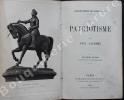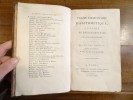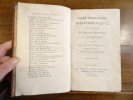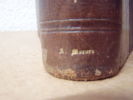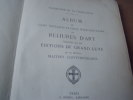-
Type
Art print (2)
Autograph (2)
Book (32249)
Magazine (147)
Manuscript (3)
Maps (1)
Photographs (8)
-
Latest
Last 24h (20)
Last 3 days (63)
Last month (271)
Last week (14)
-
Language
Chinese (1)
Dutch (2)
English (106)
French (32161)
German (10)
Greek (1)
Italian (112)
Japanese (1)
Latin (5)
Polish (2)
Portuguese (4)
Russian (3)
Spanish (3)
Swedish (1)
-
Century
16th (33)
17th (77)
18th (571)
19th (4417)
20th (11713)
21st (1763)
-
Countries
Belgium (6518)
Brazil (15)
Canada (13)
Côte d'Ivoire (30)
Denmark (146)
France (24472)
Germany (8)
Greece (3)
Netherlands (1)
Switzerland (1206)
-
Syndicate
ALAC (13)
CLAQ (5)
CNE (20)
ILAB (14300)
NVVA (498)
SLACES (497)
SLAM (13578)
SNCAO (64)
"Le grand livre des poissons; avec le portrait psychologique le plus complet, le plus révélateur, sur votre signe et sur ses rapports avec les autres; des explications simples pour dresser vous-même votre thème, l'interpréter aisément, en tirer les grandes lignes de votre avenir.Collection : Les grands livres du zodiaque."
Paris, Tchou, 1981. 21 x 29, 303 pp., nombreuses illustrations en N/B, reliure d'édition carton imprimé, bon état.
Gibiers et Chasses d'Europe
Préface de J. de Witt. 11 dessins de R. Reboussin et 21 gravures. Nombreuses photos. Payot 1939. Petit in-4 en demi-maroquin. 269 ff + table des matières. Bon état.
Abrégé d'anatomie et de physiologie humaines
1988, Lamarre Poinat, in-8 broché de 350 pages, Abrégé d'anatomie et de physiologie humaines, 2ème édition | Etat : bon état, défraîchi, petits accrocs sur la couverture (Ref.: ref90496)
Lamarre Poinat
De l'histoire considérée comme sciene
Hachette et Cie. 1894. In-8. Broché. A relier, Couv. partiel. décollorée, Dos abîmé, Intérieur bon état. 415 pages. Dos cassé et fané.. . . . Classification Dewey : 500-SCIENCES DE LA NATURE ET MATHEMATIQUES
Classification Dewey : 500-SCIENCES DE LA NATURE ET MATHEMATIQUES
Le Patriotisme.
P., Librairie Hachette, 1881, 1 vol. in-12 (180 x 110) relié pleine percaline bleue, décors dorés éditeur aux plats et dos, tranches rouges, de (2) ff. (faux-titre et titre) - II - 268 pp. - 16 pp. (catalogue de l'éditeur).Dos légèrement insolé, quelques taches dans le texte, bel exemplaire au cartonnage frais.
De la "Bibliothèque des Merveilles" publiée sous la direction de M. Edouard Charton. Deuxième édition illustrée de 4 héliogravures..
LETTRES MINERALOGIQUES ET GEOLOGIQUES SUR LES VOLCANS DE L’AUVERGNE, ECRITES DANS UN VOYAGE FAIT EN 1804. PAR LACOSTE, DE PLAISANCE, EX-PROFESSEUR D’HISTOIRE NATURELLE A L’ECOLE CENTRALE DU DEPARTEMENT DU PUY-DE-DOME…
A CLERMONT. DE L’IMPRIMERIE DE LANDRIOT. AN XIII - (1805). IN-8 BROCHE (14 X 21 X 5 CENTIMETRES ENVIRON) DE (6) + VII + (1) + 459 ET (3) PAGES, COUVERTURE MUETTE D’ORIGINE. AVEC DEUX GRANDS TABLEAUX REPLIES. EDITION ORIGINALE. ENVOI D’AUTEUR MANUSCRIT EN PARTIE BASSE DU FEUILLET DE TITRE: «L’AUTEUR FAIT HOMMAGE DE CET OUVRAGE A MONSIEUR DE REYNES, MAIRE DE PLAISANCE...». BON EXEMPLAIRE «DANS SON JUS», TEL QUE PARU AU TOUT DEBUT DU XIX°.
Histoire des sciences de l'Antiquité à nos jours.
Couverture souple. Broché. 659 pages.
Livre. Editions Tallandier, 2004.
Histoire des sciences de l'Antiquité à nos jours
Tallandier Tallandier, 2005. Très fort In-8 broché, 659 pages. Bon état
Toutes les expéditions sont faites en suivi au-dessus de 25 euros. Expédition quotidienne pour les envois simples, suivis, recommandés ou Colissimo.
Ornements d'Église. Vêtements ecclésiastiques. Bronzes. Orfèvrerie. Statue.-
Poitiers. Sans date, autour de 1900. Dépliant in-8 (164 x 246mm) sur 8 faces + une feuille additionnelle, imprimé et illustré en noir, photo de la devanture du magasin (62 rue Gambetta) en 1re page. Première page un peu piquée sinon bon exemplaire.
Les fournitures religieuses|de Poitiers.
"LE POURQUOI DU COMMENT / POURQUOI LES ETOILES SCINTILLENT-ELLES? - D'OU VIENT LE NOM DU COCKTAIL ""BLOODY MARY""? - QUELLE EST LA DIFFERENCE ENTRE UNE COMETE ET UN ASTEROÏDE? - ETC..."
ALBIN MICHEL. 2004. In-8. Broché. Bon état, Couv. convenable, Dos satisfaisant, Intérieur frais. 252 pages - Quelques annotations sur la page de titre au crayon a papier.. . . . Classification Dewey : 500-SCIENCES DE LA NATURE ET MATHEMATIQUES
Classification Dewey : 500-SCIENCES DE LA NATURE ET MATHEMATIQUES
LE POURQUOI DU COMMENT : Quelle est l'origine du poisson d'avril ? , Les éléphants ont-ils une mémoire infaillible ? Pourquoi l'eau de mer est salée ? ,etc
FRANCE LOISIRS / ALBIN MICHEL. 2005. In-8. Broché. Bon état, Couv. convenable, Dos satisfaisant, Intérieur frais. 229 pages. Tampons de bibliothèque et 1 étiquette de bibliothèque sur le dos.. . . . Classification Dewey : 500-SCIENCES DE LA NATURE ET MATHEMATIQUES
Classification Dewey : 500-SCIENCES DE LA NATURE ET MATHEMATIQUES
VOYAGE PITTORESQUE DANS LES BASSES-PYRÉNÉES, suivi d'une notice sur Cambo, ses eaux minérales et ses environs.
1834 Bayonne, Jaymebon [et]Paris, Arthus-Bertrand, 1834. In-8 (138 X 215) demi-veau fauve, dos lisse orné de filets dorés, fleurons, roulette dorée en queue et tête, pièce de titre chagrin grenat, plats de la couverture conservés, tranches marbrées (pastiche de reliure ancienne) ; 150 pages (dont faux-titre et titre), (1) f. de table des matières. Tampon encré en tête du premier plat de la couverture et sur le faux-titre : « Dr. Aparisi Serres ».
ÉDITION ORIGINALE de cet ouvrage « RARE » (Labarère & Dendaletche), dédié à "Madame Marceline Valmore Desbordes" [sic] et dont l'action se déroule au pays basque, avec notamment le détail de nombreuses excursions à Itzatsou, au Mondarrain, à Espelette, Hasparren, Saint-Jean-de-Luz, etc. (DENDALETCHE, 1031 - LABARÈRE, 831). BEL EXEMPLAIRE présenté dans un pastiche de reliure ancienne finement réalisé. NICE COPY. PICTURES AND MORE DETAILS ON REQUEST.


Phone number : 06 21 78 12 79
Traité Elémentaire d'Arithmétique, à l'usage de l'école centrale des Quatre-Nations.
Paris, Courcier, 1804. In-8 en plein veau marbré au dos lisse orné de fleurons dorés. Xv, 155 pp. Coiffe supérieure arasée, manque de cuir aux coupes, et sur deux coins. Mouillure marginale sur les 6 premiers feuillets.
LA RECHERCHE SCIENTIFIQUE DANS LES TERRITOIRES D'OUTRE-MER
La Recherche Scientifique dans les Territoires d'Outre-Mer. 1938. In-8. Broché. Bon état, Couv. légèrement passée, Dos satisfaisant, Intérieur frais. Plaquette de 15 pages. Etiquette de code sur le 1er plat. Tampon d'Hommage de l'auteur sur le 1er plat.. . . . Classification Dewey : 500-SCIENCES DE LA NATURE ET MATHEMATIQUES
Congrès de la RSTOM. Classification Dewey : 500-SCIENCES DE LA NATURE ET MATHEMATIQUES
Inventaire des périodiques scientifiques des bibliothèques de Paris -- EDITION ORIGINALE
P., Masson, 1924/1925, un fort volume in 8 relié en demi-chagrin marron à coins (reliure de l'époque), 15pp., 1102pp., (1)
---- EDITION ORIGINALE - Bibliographie fort intéressante recensant tous les périodiques scientifiques se trouvant dans les bibliothèques parisiennes**6712/K7
"Lacs et rivières, milieux vivants - ""Ecoguides"""
Bordas. 1991. In-8. Broché. Bon état, Couv. convenable, Dos satisfaisant, Intérieur frais. 255 pages - nombreuses photos et illustrations en couleurs et en noir et blanc dans et hors texte.. . . . Classification Dewey : 570-Sciences de la vie
Classification Dewey : 570-Sciences de la vie
[Observatoire de Paris] - LACROIX, Jacques ; Prof. J. DELLOUE (Président)
Reference : 51928
(1966)
Thèses présentées à la Faculté des Sciences de l'Université de Paris, pour obtenir le grade Docteur Ingénieur : 1ère thèse, Réalisation d'une expérience de radioastronomie spatiale ; 2ème thèse, (Proposition de la Faculté des Sciences) Les radiotélescopes basse fréquence. ( Thèses soutenues le 19 décembre 1966 ) [ Exemplaire dédicacé par l'auteur ]
Envoi de l'auteur, 1 vol. polycopié à spirales in-4, 1966, Observatoire de Paris, 1966, 180 pp.
Très bon état pour cette thèse de doctorat en Astronomie. L'expérience décrite dans la thèse a été menée à l'observatoire de Meudon, sous la direction de Jean-Louis Steinberg (mesure à 1.6 et 2.4 Mhz). Après ses études et son doctorat, Jacques Lacroix travailla notamment à l'observatoire de Bordeaux (site de Floirac).
Collection de La Croix-Laval. Album de cent soixante et onze (171) reproductions de reliures d'art exécutées sur des éditions de grand luxe par les meilleurs maîtres contemporains.
1902 Paris, A. Durel, (Hélio. Fortier Marotte), 1902. fort In-4,reliure signée en pied, A.MOCARD ?,demi maroquin tabac,dos à nerfs et fleurons dorés; (2)-(172) ff., 4 pp., (1) f. . COMPLET des 172 planches (dont la 132 bis) montées sur onglet, des 2 ff. de titre, des 2 ff. de table, et du feuillet d'errata. Reliures par Chambolle-Duru, Cuzin, Lortic, Marius Michel, Mercier, Meunier, Pétrus Ruban, etc.
Description des reliures modernes composant la collection du Vte de La Croix-Laval. (1888-1902). Les cent livres sont décrits un par un, reproduits à travers 172 planches hors texte en couleurs et classés dans l'ordre alphabétique des relieurs: Amand, Carayon, Chambolle-Duru, Champs, Cuzin-Mercier, S. David, Gruel, Joly, Kauffman-Petit, René Kieffer, Lortic père, M. Lortic, Magnin (de Lyon), Marius Michel, Mercier, Meunier, Raparlier, Pétrus Ruban et Trautz-Bauzonnet. Remise de 20% pour toutes commandes supérieures à 200 €
La faune marine dans la décoration des plats à poissons , étude sur la céramique grecque d'Italie Méridionale
Edition Léon Lacroix, Verviers Malicorne sur Sarthe, 72, Pays de la Loire, France 1937 Book condition, Etat : Bon broché, sous couverture rempliée grand In-8 1 vol. - 152 pages
14 figures dans le texte - 40 planches hors-texte de reproductions en héliogravure Contents, Chapitres : faune marine dans la céramique grecque - plats à poissons (provenance - chronologie et centres de fabrication - description - destination - textes et inscriptions) - faune marine (plat de Taman - animaux représentés : poissons osseux - poissons cartilagineux - mollusques - céphalopodes - coquillages et crustacés) - conclusion, inventaire des plats à poissons contenus dans les principaux musées - tables des figures, des planches, des matières légère pliure sur la couverture, sinon tres bon etat
Une liste de noms de poissons dans une inscription béotienne , extrait du tome VI, 1938 (mélanges Emile Boisacq)
Annuaire de l'Institut de Philologie et d'Histoire Malicorne sur Sarthe, 72, Pays de la Loire, France 1938 Book condition, Etat : Bon broché In-8 1 vol. - 7 pages
Sciences et lettres au Moyen-Age et à l’époque de la Renaissance.
In 4 reliure d’éditeur rouge demi-chagrin très orné,titre fers,filets,roulettes,entrelacs dorés.Plats percaline rouge décorée de fers,filets,entrelacs,petits points dorés reliure de Magnier 610 pages,tranchesdorées,13 chromolithographies de Compere,Daumont,Pralon & Werner,et 400 gravures sur bois dans et hors-texte.Firmin Didot fr,fils & Cie 1873 superbe reliure.
Sciences et lettres au Moyen Age et à l’époque de la Renaissance.
In 4 reliure éditeur, demi-chagrin rouge, titre, fers en long, entrelacé, filets, dorés. Plats percaline rouge chagrinée, plaque dorée de SOUZE sur les plats. Reliure évoquant les riches reliures de la Renaissance. Reliure LENEGRE. Tranches dorées. Faux-titre, frontispice en chromolithographie sous serpente : Le Roi de Navarre, titre, IV, 612 pages, 13 chromolithographies hors-texte, sous serpentes, par COMPERE, DAUMONT, PRALON et WERNER, 400 gravures sur bis dans le texte et hors texte Libraire Firmin DIDOT & Cie 1877..une charnière intérieure, habilement restaurée.
XVIIIème siècle. Institutions, usages et costumes France 1700 - 1789 .
,Paris, Librairie de Firmin Didot Frères, Fils et Cie 1875, VIII-520 pp pp., 1 vol. in 4 relié Ouvrage illustré de 21 chromolithographies et de 350 gravures sur bois d'après Watteau, Van Loo, Rigaud, Boucher, Lancret, J. Vernet, Chardin, Jeaurat, Bouchardon, Saint-Aubin, Eisen, Gravelot, Moreau, Cochin, Wille, Debucourt, etc. . Reliure pastiche du 18ème siècle en pleine basane mouchetée, dos à 5 nerfs orné au petits fers de caissons et fleurons dorés, pièces de titre et d'auteur en maroquin rouge et vert, tête dorée, couverture conservée, quelques rousseurs, emboitage. Bel exemplaire.
XVIIIème siècle Lettres Sciences et Arts.France 1700-1789
In 4 reliure d’éditeur rouge plein chagrin très orné,titre fers,filets,roulettes,entrelacs dorés.Plats décorés de fers,filets,entrelacs,petits points dorés.Superbe reliure signée de SMEERS.559 pages,tranches dorées,16chromolithographies de Durin,Gaulard,Bayalos... et 250 gravures sur bois dans et hors-texte Firmin Didot & Cie 1872.superbe reliure plus rare en reliure plein chagrin
 Write to the booksellers
Write to the booksellers

